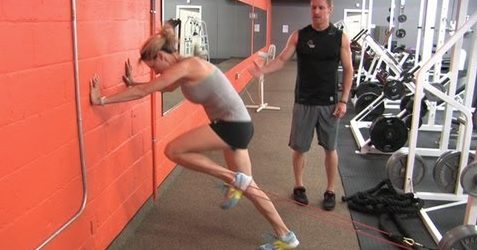Want to increase your power, strength, and endurance for triathlons, running or cycling? You could simply ride, run and swim longer, harder, and faster. However, there is another often overlooked method – strength training.
Weight training for endurance athletes should not be an afterthought. Building strength should be an integral part of your overall yearly plan just like your weekly track workouts or hill repeats. Attack it with the same prep building, periodization and recovery phases that you would with the rest of your training. The off-season means that it is time to hit the gym. One question we hear many times from endurance athletes is what type of weights to lift? Light weights with a high number of repetitions or heavy weights and fewer sets and reps? It all depends…
The days of only doing low weight/high reps weight training all season long is over. Most training for endurance athletes can be classified as low weight/high repetition. For example, if you pedal 90 RPMs for 60 minutes that equates to 5400 reps of light weight. That’s a perfect example of high rep training. Most endurance athletes do this type of “weight” training day after day with their regular workouts. A focused period of heavier weight training can pay big dividends by increasing muscular strength as well as improving neuromuscular firing patterns.
Does that mean there is no place for a light weight and high reps strength training program? We use a light weight/high rep strength training period in the initial phase of weight training to prepare the body for the heavy loads we will demand of it later.
We also need to ensure that there is sufficient connective tissue strength, core stability and body balance. A few functional strength tests can detect any specific weaknesses or areas that may need additional focus. For example, we may perform an overhead squat assessment and determine that you have extremely tight calves (while squatting your heels rose and your feet flattened or your toes turned outward).
Our first weight training phase is called Corrective Stabilization and focuses on identifying and correcting these weaknesses and imbalances. Skipping this important phase can lead to chronic injuries and a diminished performance during the season.
The fix for all this is fairly simple and involves the use of a foam roller, stretching, and some modest strength exercises. A few other function strength tests round out the initial evaluation.
The Base Period is the next phase of weight training and focuses on a short period of low weight high rep training, developing proper form and technique, in order to prevent injury later in the program. An athlete unfamiliar with strength training may start with only one set of 15-20 reps and build up to three sets of higher (20-25) reps. The Base Period may seem boring but focusing on technique and will pay huge dividends later on. The types of exercises are general strength and multi-planer exercises like lat pull-downs, step ups, squats, cable wood chops, and as always core abdominal work.
Over the next 6-8 weeks we begin to increase the weight, drop the reps, and enter into more sport specific movement patterns of the Sport Build Period. Much of the focus in this period is on the nervous system. In this phase we will increase neural drive and motor unit recruitment – teaching the body to recruit and activate more of the specific muscle fibers that we already have rather than “bulking up”. For runners, triathletes and cyclists, the focus is on improving the recruitment of muscle fibers in the quadriceps, hamstrings and gluteus muscles.
If you follow a proper progression you will still be able to do quality swim, bike and run workouts. You will also be amazed at how much stronger you are and how fast you recover.
EXAMPLES OF EXERCISES
Exercises can include single leg squats or Bulgarian squats of 4-8 repetitions. These exercises are done standing with the rear leg on a bench and the front leg in front of the torso. As you squat with the front leg be sure not to allow the front knee out past the toes as this can cause unnecessary loading of the patella or knee cap. One tip is to keep your back erect and straight.
The single leg squat is a great sport specific exercise for running because it strengthens the gluteus muscles while simultaneously stretching the opposite hip flexor. The benefits include greater running economy and increased stride length with little or no extra effort.
Another exercise that can have an important impact of runners is the eccentric hamstring exercise or Nordic Hamstring. This exercise can be done either with the help of a partner or with a Glute-Hamstring Machine. Since the active phase of the hamstrings is the eccentric or lengthening portion, this exercise is important to increase strength and endurance as well as decrease the incidence of injuries. It is an eccentric movement where the athlete holds his feet in the foot pads of the Glute-Hamstring Machine or is kneeling on the floor with a partner holding the ankles and lower legs firmly. From this kneeling position, with slowly lowers him or herself down towards the floor until the legs are straight.
Cable straight-leg pull downs are an excellent exercise for working hamstrings in a full range of motion while increasing flexibility at the same time. Finally, recent research shows Nordic hamstring exercises are great exercises for increasing eccentric strength and decreasing hamstring muscle strains and injuries.
